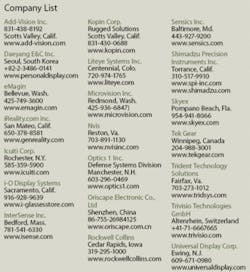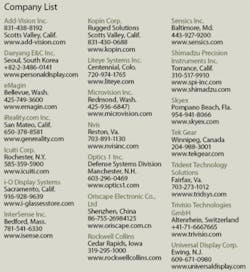Flexible and wearable display technologies are critical to today’s dismounted soldiers
By Courtney E. Howard
The U.S. Department of Defense is increasingly investing in the advancement of display technology for military applications. The U.S. Army, in particular, is a driving force in the acceleration of display technology for defense environments.
The Natick Soldier RD&E Center (NSRDEC), located at the U.S. Army Soldier Systems Center in Natick, Mass., and working under The Army’s Research, Development, and Engineering Command (RDECOM), is focused on outfitting tomorrow’s soldiers with the most innovative electronics technologies, including the latest head-mounted displays, as part of the Future Force Warrior (FFW) Science and Technology initiative. Head-mounted displays will provide FFWs with sensor data and a communications link with others on and off the network-centric battlefield.
The Army also is working with the Defense Advanced Research Projects Agency (DARPA) on its Advanced Soldier Sensor Information Systems Technology (ASSIST) effort. ASSIST takes advantage of display technology, in combination with soldier-worn sensors, to augment the soldier’s situational awareness and to improve his recall and reporting capabilities.
At the same time, the U.S. Army’s Warrior programs-including the Land Warrior, Air Warrior, and Mounted Warrior Soldier Systems-integrate a small, helmet-mounted display to deliver command, control, communications and computer (C4) data and video to fielded soldiers. General Dynamics C4 Systems in Scottsdale, Ariz., heads up the Mounted Warrior, Land Warrior, and Air Warrior programs, which are managed by the U.S. Army Program Executive Office-Soldier in Fort Belvoir, Va. General Dynamics C4 Systems contracted Microvision in Redmond, Wash., to provide full-color, helmet-mounted displays for the U.S. Army’s Mounted Warrior Soldier System.
Additionally, the Flexible Display Center (FDC), established two years ago as part of a $43.7 million, five-year agreement between the U.S. Army Research Laboratory (ARL) and Arizona State University, combines the skills and resources of academia, industry, and government to develop thin, light, rugged, and low-power computer screens that are flexible enough to conform to a soldier’s sleeve, for example. In February, the FDC announced the world’s first flexible, four-inch-diagonal, active-matrix QVGA reflective electrophoretic display fabricated on DuPont Teijin Film’s heat-stabilized PEN polyester film. This technology is likely to contribute to the production of display sleeves, flexible printed electronics that form a display on the sleeve of a soldier’s uniform.
Display technology is considered to be critical to the Army’s network-centric initiatives. “Flexible display technology has the potential to be implemented in a wide variety of applications from command centers, to vehicle platforms, to individual soldiers. It will revolutionize the way in which information is disseminated on the battlefield, increasing both the lethality and survivability of the Future Force,” John Miller, then acting director of the U.S. Army Research Laboratory, was quoted as saying in 2004. This statement is no less true today. In fact, flexible and wearable displays are capable of serving a wide variety of military functions - including situational awareness, thermal imaging, simulation and training, and ISR to name a few. “Wearable displays are used in night vision goggles and new command, control, communication, computers, intelligence, surveillance, and reconnaissance (C4ISR), command and control (C2), and weapon systems control applications,” Ross Smith, co-founder and president of Quantum3D in San Jose, Calif., acknowledges.
Technology companies are answering the DOD’s call for innovative wearable and flexible displays, investing in research and development of rugged, reliable solutions for the soldiers of today and the future. Military personnel are requesting displays with high resolution, low power consumption, small size, and the ability to withstand shock and vibration, and various environment conditions. “Each of these is important, along with cost, color depth, daytime and NVG readability, and life cycle support,” Smith notes. “The order of importance depends on the mission. Our customers want super-rugged, multiyear support, small and low-power, in general.”
Today’s wearable display systems, offered in monocular and binocular form factors, are designed to take up little viewable space. Yet, a new innovation in display technology delivers augmented reality, whereby a head-mounted or wearable display superimposes computer-generated images and information onto a real-world view. As a result, soldiers remain engaged with their environment, while simultaneously benefiting from digitally delivered, real-time operational data delivered on-screen.
null

